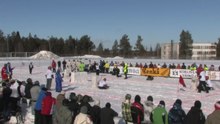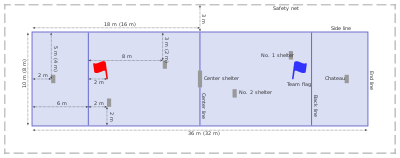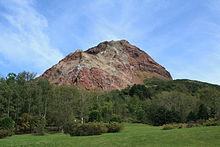Yukigassen
Yukigassen ( Japanese 雪 合 戦 'snow battle ' ) is a Japanese team sport that is based on the principle of a snowball fight . Yukigassen is the general Japanese term for snowball fight. The game is popular in several countries around the world, and official world championships are held annually on Hokkaidō . The style of play is described by the BBC as a mixture of capture the flag and dodgeball .
regulate
In a Yukigassen match, two teams with seven players each face each other on a snow-covered playing field . Each team has 90 snowballs at their disposal, with which opponents can be thrown off and taken out of the game. The aim is to throw off as many opponents as possible or capture their team flag in a three-minute round. Catching the flag and throwing off all opponents earns 10 points, otherwise 1 point is awarded for each throw. Three rounds are played, the points summed up at the end.
There is an official 24-page set of rules for the World Championships, which regulates the playing field (36 × 10 m) and its design elements as well as the course of the game and safety. For protection, the players wear helmets with visors, and a net ensures the safety of the audience. As is usual with team sports, compliance with the rules and the playing time are monitored by several referees . For fouls are red and yellow cards awarded. The snowballs are not hand-made, but machine-made and must have a diameter between 6.5 and 7 cm.
History and venues
Yukigassen was invented in 1989 in the small town of Sōbetsu on the northernmost main Japanese island of Hokkaidō to stimulate local winter tourism. At the foot of the Shōwa-shinzan mountain , a cryptodome that was created in the course of a volcanic eruption in 1944 , world championships have been held annually since then. While 70 teams competed in the first tournament, in 2017 there were already 111 in front of an estimated 26,000 spectators. There are also separate competitions for women and juniors. A separate magazine has been published for Yukigassen since 2009. In 2011 there were already over 2000 teams in Japan.
As early as 1992, a Yukigasse competition outside of Japan took place in Sweden for the first time. Meanwhile, several countries around the world hold national championships, through which it is possible to qualify for the two-day World Cup tournament at Shōwa-shinzan. Wildcards are also given to teams from countries without their own competitions . The sport has been organized in a world association since 2013. The International Alliance of sports Yukigassen (IAY) includes Japan, Australia , Belgium , Finland , Canada , the Netherlands , Norway , Russia , Sweden and the USA . Separate tournaments are held in China and Thailand . Some of the venues are Kemijärvi (Finland), Jasper (Canada), Murmansk (Russia), Luleå (Sweden) and Anchorage (USA).
Web links
Individual evidence
- ↑ a b c Lindsey Galloway: Japan's epic snowball fighting championship. BBC , February 3, 2014, accessed November 29, 2017 .
- ^ A b Showa-Shinzan International Yukigassen - Laws of the Game. International Alliance of sports Yukigassen, accessed November 30, 2017 .
- ↑ a b History of Yukigassen. International Alliance of sports Yukigassen, accessed November 30, 2017 .
- ↑ Sumitra: Yukigassen - Competitive Snowball Fighting from Japan. December 5, 2011, accessed November 29, 2017 .
- ↑ About IAY. International Alliance of sports Yukigassen, accessed November 30, 2017 .
- ↑ What's Yukigassen? International Alliance of sports Yukigassen, accessed November 30, 2017 .


